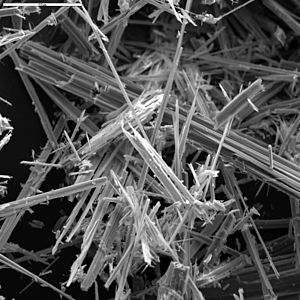
I’ve written about the similarities in asbestos and nanofibers before – and therefore the similar dangers of the two substances. Asbestos was in use – and slowly killing people – for many hundreds of years before the connection was made between breathing it and dying of asbestosis or mesothelioma decades later. Nanofibers are incredibly strong and tough fibers of microscopic width – like one-one thousandth the diameter of a human hair – that are used to make supertough and strong composite materials.
The problem is that nanofibers, like asbestos fibers, are so tiny that people can easily breathe them deep into their lungs or ingest them (say, when eating a sandwich on the job). Inside the human body these fibers eventually cause scarring and disease and death.
Now I’m happy to report that the National Institute of Occupational Safety and Health (NIOSH) has finally published a safety standard for the length of nanofibers. Workers involved in manufacturing items that use nanofibers must now be protected from exposure to nanofibers. The standard is set “as low as we can measure” according to Andrew Maynard, chair of environmental health sciences at the University of Michigan in Ann Arbor. In other words, they want literally no loose nanofibers to be allowed in the air of a plant that uses them.
It took centuries to stop companies from recklessly exposing workers to asbestos fibers. Now perhaps all the asbestos lawsuits now being filed all over the world are serving as a warning to companies – and nanotech training schools – that they can’t pretend there’s no danger to people working with nanofibers.





